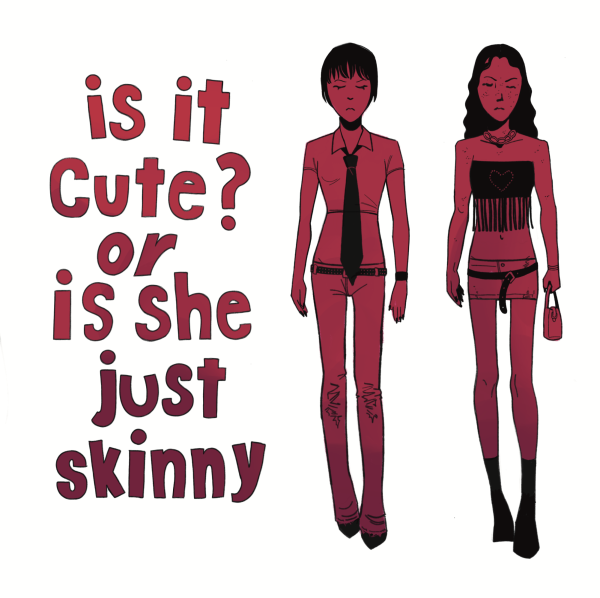Fashion, as an industry, has always been deeply intertwined with body ideals and race. As we witness the resurgence of Y2K fashion—low-rise jeans, tiny baby tees, slinky dresses—this trend is also rekindling “skinny culture” and simultaneously denying women of color (WOC) their flowers. Y2K style isn’t just a nostalgic fashion moment—it was the epitome of an era when iconic WOC started so many fashion trends: Missy Elliot, Alicia Keys, Destiny’s Child. With the whitewashed revival of Y2K, all I’m left thinking is—I can’t believe fashion is still centered around thin, white bodies.

The turn of the millennium gave rise to some of the most iconic fashion trends, but it also marked a peak in the glorification of a hyper-thin body standard. White figures like Britney Spears, Paris Hilton and Kate Moss were the style icons of the time—white, slim, often waif-like, with exposed midriffs and impossibly low waistlines. Y2K fashion, in its original form, was created for these types of bodies and built off the cultures of women of color.
Y2K fashion’s resurgence has also largely spotlighted white girls as its main icons, despite many of the trends within this subcategory being either started by or heavily inspired by WOC. From the popularization of bedazzled accessories to iconic hairstyles like baby hairs and braided updos, the Y2K aesthetic traces back to the influence of Black and Latina women in hip-hop and urban culture.
Yet, these contributions are often erased or diminished in mainstream fashion narratives, with white celebrities and influencers being positioned as the face of the trend. The whitewashing of Y2K, culture-inspired fashion not only ignores its true origins but also reflects a broader pattern in the fashion industry, where trends born in communities of color are co-opted and stripped of their cultural significance and flair.
The fashion industry, historically, has also always centered around the “ideal” body, which for decades has been thin, white and able-bodied. Despite efforts towards size inclusivity, most high fashion and mainstream trends still primarily cater to smaller sizes. This is glaringly evident in the Y2K revival.
While designers and brands claim to embrace diversity, their collections often default to recreating the original cuts and shapes of the early 2000s, which were meant for specific body types.
The reemergence of Y2K fashion is a reflection of society’s unchanging preference for thinness, cloaked in the facade of nostalgia. Even though the fashion industry has made strides toward including plus-size models and offering a wider range of sizes, there’s still an underlying assumption that the “ideal” body is slim. Just look at the way these clothes are marketed: thinner models showcasing the trend, influencers with small waists donning low-rise jeans and barely-there crop tops. While people of all shapes and sizes are participating in the Y2K revival, the dominant imagery remains attached to thinness.
But why is this? At its core, fashion is about aspiration. Designers create clothing that evokes a lifestyle or a state of being that consumers want to attain. Unfortunately, for far too long, that aspiration has been linked to thinness, which is now even starting to be linked to eating disorders.
Y2K fashion, in its second wave, is no different. The culture around it glorifies the sleek, minimalistic look that favors thin bodies—emphasizing silhouettes that most people, frankly, will not fit into comfortably without conforming to that ideal.
This isn’t to say that skinny people shouldn’t wear or celebrate these trends—fashion should be for everyone. The problem arises when the industry and its associated media send a subtle (or not so subtle) message that certain body types are more desirable or fashionable. When the majority of fashion imagery is based around thin bodies, it reinforces the notion that clothing—and by extension, the culture surrounding it—is exclusive to those who meet specific body criteria.
The Y2K resurgence has reignited this conversation around body standards. With fashion trends inherently tied to cultural ideals of beauty, we have to ask whether it’s possible to celebrate this aesthetic while simultaneously challenging the exclusionary body ideals it comes with. Can Y2K fashion be reimagined for all body types, or is it too rooted in the skinny culture of its past to be inclusive?
As consumers, we have a role to play. We can demand better representation, we can support only brands that truly embrace size inclusivity and we can reject the toxic narrative that certain trends are only for certain body types. Y2K fashion is not inherently problematic, but when it comes with the baggage of skinny culture, we have to critically examine whether we’re really showing love to past fashion—or if we’re just recycling outdated and harmful beauty standards.
We’re in the 21st century. Fashion has always been a reflection of society’s values, and if we’re serious about inclusivity and body positivity, then our trends should reflect that.


